History of Holography
2. Holography
From times immemorial people have always desired to display the surrounding objects, their memories and visions. The arts of photography and cinematography originated in this effort. However, people used only a symbolic representation of three-dimensional objects on two-dimensional plane. Although it was simple, it did not offer a complete illusion of the displayed reality. Then holography was invented.
A common method of recording objects is photography. The objects are displayed by the photographic camera following the laws of geometric optics, i.e. also on the basis of linear propagation of light. The photographic emulsion registers the light intensity. It means that only the amplitude of light waves is recorded. As a photograph does not involve any information about the wave phase the information about location and space structure of the object is lost.
The photographic record of a specific object is obtained when through the converging lens (3) we create a sharp image of the object in the plane of the photographic plate. If the object is rather distant (at infinity), at the distance of more than 25 m, the photographic plate is located in the focal plane of the objective (3) (Fig. 2–1 a).
If we take a photograph of a close plane object, for example a picture, we locate the camera that the planes of the chart and photographic emulsion be parallel to each other (Fig. 2–1 b).
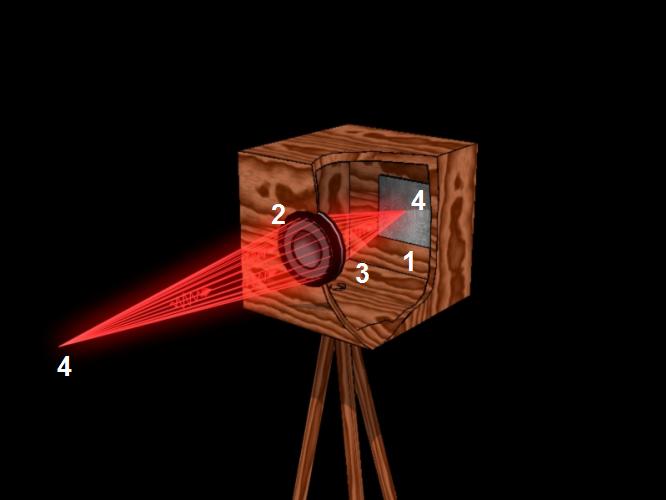
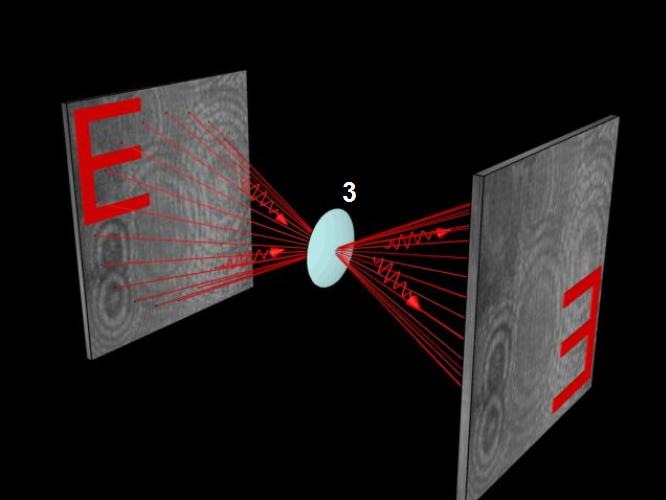
b) Obtaining of a flat object image
1 – glass plate, 2 – shutter, 3 – objective (lens), 4´ – image of the point 4
Photography does not allow any reconstruction of the wavefront that made the display possible. This absence has been eliminated by holography.
Holography is a method of optical information recording. The term holography comes from the Greek word holos – total and grapho – record, hence the word holography means a total recording about the coming light wave. What is recorded on the hologram is not the image of the object itself, but the structure of the light wave deformed by its transition through a phase object or reflected from a non-transparent object. Holography makes it possible to reproduce the light wave in an exact way. It is a total record about the wave, i.e. a record of both its amplitude and phase. The phase of the light wave is recorded indirectly through the light intensity: the wave carrying information about the displayed object (the object wave) interferes with the wave whose phase distribution is known (the reference wave). Through the interference the phase variations are transformed into amplitude variations because the amplitude of the light wave in the given place depends on the phase difference of both wave motions. Thus a stationary interference field containing information about the given object is generated. This field is recorded by exposing on a special high-resolution photographic material and thus a holographic record called hologram is created.
2.1 History of Holography
The origin of holography dates back to 1947 when D. Gábor, the English physicist of Hungarian origin, developed the hypothesis of holography when working on his electron microscope resolution improvement. Gabor derived the term hologram from the Greek words holos "total", and gramma "message".
His paper provoked an immediate answer from all over the world. On this development participated also G. L. Rogers, A. B. Baez, H. El-Sum, P. Kirkpatrick and M. E. Haine. At that time, the most accessible source of light for holograms was the mercury vapour lamp.
In 1947–48, Gábor and his colleague J. Williams obtained their first flat holograms at the diffraction of the mercury vapour lamp beams (Fig. 2–2 a).
During their experiments they used a shutter with a diameter of 1 to 2 µm and exposed for several hours. The principal limitation that prevented Gábor from obtaining a quality image dwelled in failures that occurred during the reconstruction of the image in consequence of simultaneous creation of both the real and unreal images (Fig. 2–2 b).
Gábor intended to carry on his experiments with the electron microscope. The holography principle fell into oblivion for quite a long time because before Gábor came to new results, the image improvement of the electron microscope had been reached by different methods.
Gábor holography was limited by the use of the mercury vapour lamp. Because of low coherence of its light the holograms were not deep enough. This barrier was overcome by the invention of laser.
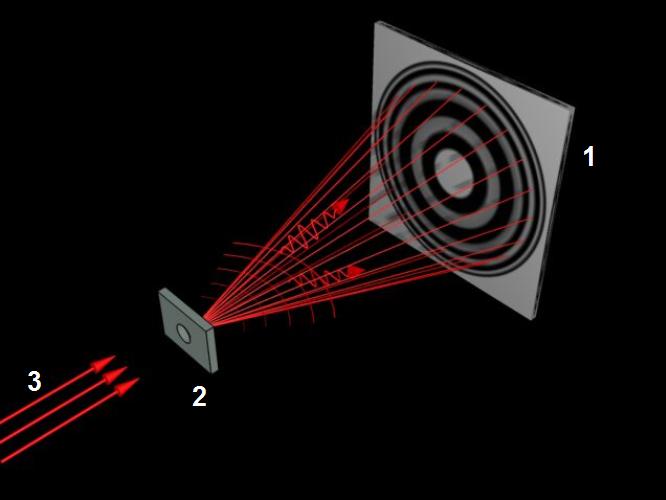
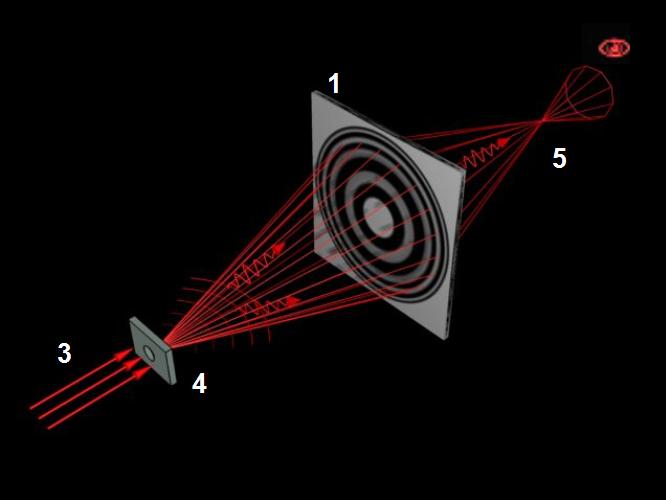
1 – hologram, 2 – point object, 3 – parallel beam of mercury vapour lamp,
4 – unreal image, 5 – real image
In 1960, the pulsed laser was developed by Dr. T. H. Maimam from Hughes Aircraft Corporation. The clear intensive light of the laser was ideal for creation of holograms and a new period of holography development started.
In 1962, American radiophysicists and opticians E. Leith and J. Upatnieks from the University in Michigan discovered that the holography can be used as a three-dimensional medium (Leith, Upatnieks, 1963). In 1964, after reading the Gabor paper they decided to double his technology by utilising laser and off-axis technique of radar development. The result was the first laser transmission hologram of three-dimensional objects (a toytrain and a bird).
They separated the reference beam from the signal beam thus excluding the mutual overlaying of the real and unreal images. The reference and signal beams intersected each other directly in front of the holographic plate in their holographic device (Fig. 2–3 a, b).
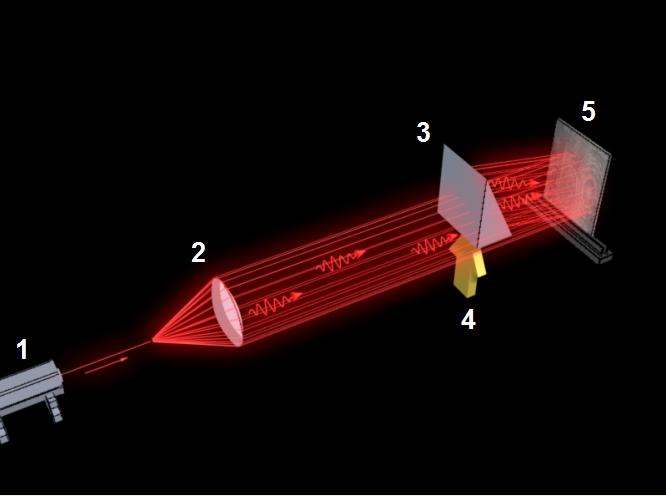
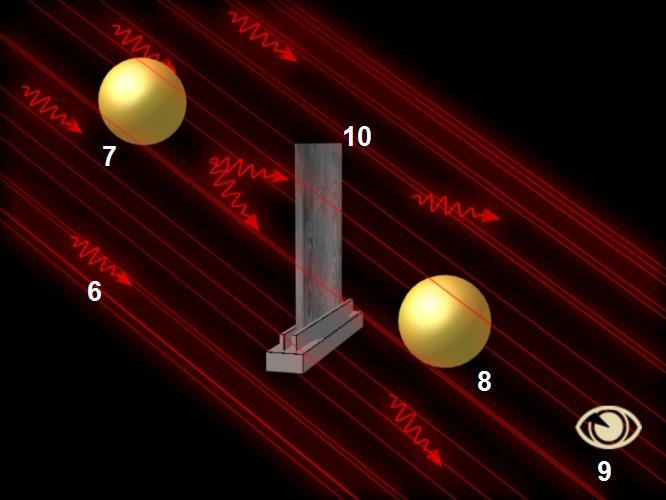
1 – laser, 2 – objective, 3 – optical wedge, 4 – object,
5 – photographic plate, 6 – laser light, 7 – unreal image,
8 – real image, 9 – observer, 10 – hologram
The image quality was further improved by dispersion lighting of the object. That is to say that during such lighting each point of the object sends a wide beam and consequently the observer (during the reconstruction) – at the sight through any random point of the hologram – at the same time sees the whole object that has all characteristics of a three-dimensional object, as was mentioned by Gábor in his first paper in 1948.
In 1962, J. N. Denisjuk, the soviet scientist, connected holography with the paper by Gabriel Lippmann, the Nobel laureate in 1908, about the photography of natural colours. Denisyuk´s approach utilising white light created a reflex hologram that was possible to watch in the light of an ordinary lamp.
While in the classical Gábor method both the object and reference beams are incident on the photographic plate from one direction, Denisjuk chose the opposite direction of propagation of both beams. Thus it was possible to record the hologram of non-transparent reflecting objects (Komar, Serov, 1987).
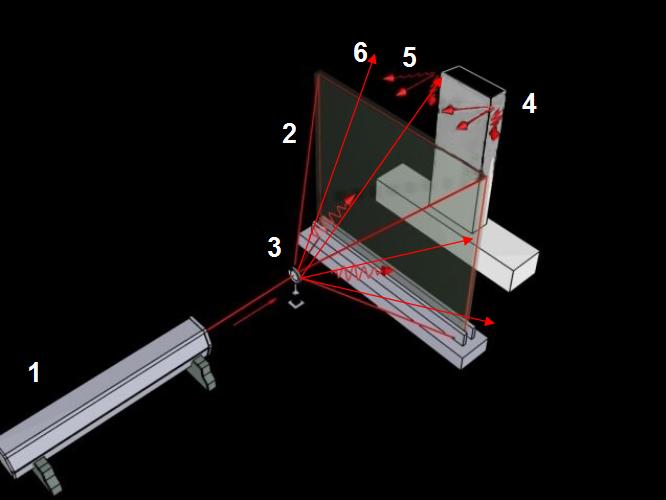
1 – laser, 2 – hologram, 3 – diverging lens, 4 – object,
5 – object beam, 6 – reference beam
Denisjuk obtained the
volume holograms during his experiments with thick layers of
recording emulsions. If the light reflects from two or more
interference maxima there also interference occurs among the
reflected beams. In consequence of this interference only the beams
of such wavelength and in such directions for which the beams
amplify come from the volume hologram without reduction.
To the development of
the holography also contributed Stroke, who elaborated the present
charts of holographic devices and theoretically suggested the
possibility to construct an X-ray holographic microscope.
In 1965, all groups of
workers: E. Leith, J. Upatnieks, A. Kozma, J. Marks and
N. Massey (University of Michigan); G. Stroke, A. Labeyrie
(University of Michigan) K. Pennington and L. Linom (Bell
Labs); and C. Schwartz and N. Hartmann (Batelle Memorial
Institute) successfully recorded the reflex off-axis holograms. The
American patent was given to Hartmann.
In 1965, R. Powell and
K. Stetson published the first article about holographic
interferometry.
In 1967, Shankoff and
Pennington developed bi-chrome gelatine as a medium for recording
holograms, which made it possible to record the hologram on any
clean smooth surface.
World Book
Encyclopaedia Science Yearbook from 1967 contained the first
mass-propagated hologram "view on the chessboard" with the
dimensions of 4 × 3".
In the same year,
Gallery Editions Inc., Ann Arbor (Michigan) operating by Lloyd
Cross, Peter Van Riper and Jerry Pethick started to exhibit
holograms.
In the same year, Larry
Siebert from Conductron Corporation used the pulsed laser designed
by himself to create the first ever hologram of a person.
Further progress in
holography was reached in 1968 when Dr. Stephen A. Benton
invented the holography of white light transition during the
research of holographic television in Polaroid Research
Laboratories. This type of hologram is visible in ordinary white
light. His invention made the mass production of holograms possible.
The first exhibition of
the holographic art was held at Cranbrook Academy in Michigan
in 1968, and the following one at Finch College Gallery in New York,
in 1970.
In the same year, the
physicist Lloyd Cross and the Canadian sculptor Gerry Pethick
developed a system with the sand table for production of holograms
that did not need any expensive laboratory optics or insulating
table to ensure stability during the exposure.
Cross et al. opened the
School of Holography in San Francisco in 1971, the first of its type
for artists and scientists.
The pioneers in the
field of impulse holography at that time were Bruce Nauman, Carl
Frederick Reutersward and Peter Nicholson. Nauman exhibited several
self-portraits with the use of impulsed laser in the USA. The first
woman to utilise holography in art was Margareta Benyon (Great
Britain).
In 1970, Reutersward
exhibited the works by Hans Bjelkhagen. Nick Phillips started to
create large formats (1 × 1 meter) of pulsed
transmission holograms
at the
University in Loughborough (Great Britain).
In 1971, Dr. Dennis
Gabor was awarded the Nobel Prize in physics for his invention of
holography in 1947.
In 1972, Lloyd Cross
developed an integral hologram by connecting the transient
holography of white light with conventional cinematography to create
three-dimensional images in motion.
Later, Cross
established the Multiplex Company for production of hundreds of
pictures utilising the holographic stereogram technology.
In the same year,
Benton changed the technology of white light transition into the
formation of black-and-white (achromatic) images.
Also in 1972, Tung
Jeong started to offer summer workshops on the holography for
non-physicists at the Lake Forest College (Illinois).
The artist Salvador
Dali gave holography another dimension by exhibiting his own
holograms at the Knoedler Gallery in New York.
Three years later, the
International Centre of Photography in New York City published
"Holography '75: The First Decade", by Jody Burns and Posy
Jackson. It presented the works of artists and scientists from
six countries.
In 1975–1984,
Rich Rallison (International Dichromate Corp., Draper) created the
first dichromatic holograms on glass plates used as trays for
jewellery, pendants for keys, etc.
While in the West the
exhibitions ran slowly, the Soviet Union ran in research and
production faster. New inventions in holographic films and emulsions
appeared.
In 1976, Victor Komar
and his colleagues at the Research All-Union Institute of Cinema and
Photography in the USSR developed the prototype for an projected
holographic film. The images were recorded by an pulsed holographic
camera (about 20 images per second). The developed film was
displayed on a holographic ground-glass screen. Two or three people
could see the film in full dimensions without glasses.
In 1976, the Museum of
Holography was established in New York City as the international
centre for understanding and development of this new medium. It was
headed by its founder Rosemary H. Jackson.
A year later, the
Museum opened its Gallery of Portraits of Famous New Yorkers
(Hol-o-fame).
Also in 1977, the
traveling exhibition of the Holographic Museum "Through the
Looking Glass" (based on the exhibition of the same name) was
opened in Toronto. It toured the USA and the whole world.
In 1983, MasterCard
International, Inc. was the first to use the hologram technology for
the security of bank credit cards.
The National
Geographic journal was the first to put a hologram on its cover.
The March 1984 issue launched to the world almost 11 million
holograms. In November 1985, another hologram on its cover
illustrated the article "Searching for the First People".
In December 1988, the
National Geographic published the most extensive hologram
ever published in the Press of such a scene. The whole cover was
holographic: the globe on the first page, 3-D printing inside and
the advertisement on the back side.
The National
Geographic issue of December 1988 had a cover worthy of this
journal: In November 1987, the publisher Wilbur Garrett decided to
use a hologram on the whole page in the anniversary issue. William
W. Smith, the press and engravings manager, was to think out how to
do it. It should be a double picture of the globe – one solid
and one exploding – to express the fragility of our planet.
Another method of
hologram mass production – photopolymer – was developed
in the Polaroid Corporation, and later by Dupont. The
photopolymer hologram is a reflection hologram giving very sharp
images. It is successfully used in advertisements, consignment mail,
wrappings and also as holographic portraits.
In March 1992, the
Museum of Holography in New York was closed. In January 1993, the
MIT Museum, Cambridge, required its complete contents including the
works by Margaret Benyon, Rudie Berkhout, Harriet Casdin-Silver,
Mesissa Crenshaw, Paula Dawson, Setsuko Ishii, John Kaufman, Sam
Moree, Ana Maria Nicholson, John Perry and Dan Schweitzer.
In November 2003,
Stephen A. Benton, the inventor of the white light transition
hologram (rainbow hologram), died. His friends and colleagues
convoked Benton Vision, and the symposium in MIT Media Laboratory in
Cambridge to remember his contribution to the field of holography
(www.holophile.com,
2006).


